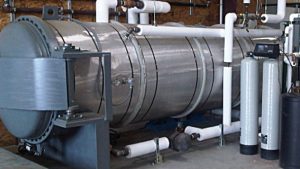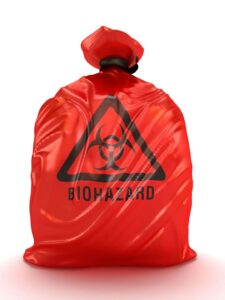Call us anytime
+1 800-455-7747
Email Us
Call us anytime
Email Us
Medical health facilities generate tons of medical waste per year. The types and volumes of waste vary across different settings, and as a healthcare worker or manager, it is vital that you understand the treatment methods for each type.
Highly infectious diseases like COVID-19 and MRSA are prevalent in the medical setting. Regularly educating yourself and your staff on the importance of safely handling and disposing of medical waste is your first line of defense in maintaining a safe work environment.
This article will explain medical waste, types of waste treatment, safe handling practices, and how to choose the best biohazard medical waste disposal company. Read on to learn how to protect your team.
The US Environmental Protection Agency (EPA) defines medical waste as a type of waste that may be contaminated by blood, bodily fluids, or other potentially infectious materials. Medical waste is most often generated by health care facilities.
By this definition, medical waste includes:
Since many things can fall under the category of “medical waste,” it may be easier to identify those not regarded as medical waste. Although some things are considered biohazards, they may not be classified as medical waste.
Most federal and state regulations do not recognize the following biohazards as medical waste:
It is important to know the difference between medical waste and non-medical waste so that you can exercise safe disposal practices for each. Personnel must treat medical waste before disposal to eradicate contaminants that may cause harm to public health or the environment.
Several treatment options exist, each unique to the type of waste being treated. In prior years, soon after passing the Medical Waste Tracking Act of 1988, the prevailing opinion was that incineration was the best method of treating most types of medical waste.
However, this method proved to have its own subset of issues, including a significant airborne mercury source. Now, other more effective treatment methods like autoclaving are far more widely used and accepted than pollution-generating incinerators.

Autoclaving is used in medical and laboratory settings as a sterilization technique. This machine utilizes high heat, moisture, and pressure to sterilize and treat medical equipment before it’s transported to the landfill or processed in an incinerator. Many modern autoclave machines have automation features making the process easier than ever before.
The autoclave process starts by removing all of the air from the chamber via a vacuum pump, replacing it with steam. It then applies pressure and high temperatures at the desired amount for a length of time predetermined by the technician.
Once the cycle is complete, the technician releases the steam from the chamber and carefully removes the contents. Containers used during the autoclaving process should be tear and puncture-resistant to reduce spills or injuries.
Autoclavable bags are bags used to securely contain medical waste materials during the sterilization process. The bags may be preprinted with the biohazardous symbol and are either self-sealing or can be tied or taped for your security.
Autoclave bags (otherwise known as sterilization bags) are temperature-tolerant and flexible containers for holding waste or other items during the autoclaving and sterilization process.
These containers are typically made from heavy-duty polythene or polypropylene material, and you can purchase them in low-temperature or high-temperature versions, depending on your needs.
Chemical waste treatment is a method of waste treatment that can be conducted on-site. It typically involves using sodium hydroxide, chlorine, and calcium oxide to deactivate and decontaminate liquid waste products.
Although this method saves time and money in packaging and transportation, it comes with its own set of hazards, including creating gaseous and volatile compounds. Only trained individuals should attempt chemical treatments.
Although the autoclave process can sterilize many types of waste products, some types of waste still must be treated by incineration. The incineration process involves using a medical-grade incinerator to burn the material.
The most common incinerators used in medical facilities are controlled-air incinerators. Due to concerns surrounding incineration and air quality, the EPA has set medical and infectious waste incinerator standards to reduce the impact on public health and the environment.
Irradiation is a type of medical waste disposal that uses gamma rays to treat harmful bacteria. It’s essentially the same type of radiation treatment used to treat cancers. The irradiation process is intended to kill off pathogens and penetrate plastic bags, meaning you won’t have to worry about handling the waste before treatment.
It is very expensive to build, operate and maintain an irradiation machine. Not only are they cost-prohibitive, but they also pose a radiation threat to your staff and have in-depth regulatory requirements, making them a less popular method of medical waste disposal.

According to state and federal regulations, after the medical waste has been treated through the proper channels, personnel must exercise proper biohazardous waste disposal. Most regulated medical waste will end up in a sanitary landfill.
These are separate from traditional landfills. Their primary purpose is to isolate this waste from regular waste material to reduce the impact on human and environmental health until deemed safe.
Biohazardous waste should never be throughout with regular trash or flushed down the drain. Improper treatment and disposal of medical waste can cause these materials to get into groundwater, contaminate the environment and negatively affect public health.
When you partner with a regulated medical waste disposal vendor, they handle the collection, transportation, and disposal of your medical waste products. This way, you can worry less about the rules and regulations that govern disposal and focus more on protecting your staff and patients.
A biohazard refers to any biological materials that pose a threat to the health and safety of living things. Biohazards can involve microorganisms, plants, animals, and their by-products. These materials can be found in many settings.
In healthcare facilities, medical waste can include:
These types of waste pose a significant risk to the public and environmental health and safety and should be handled and disposed of according to federal and state regulations.
The Centers for Disease Control classifies biohazards by their threat level. The four levels of biohazard material include:
Biohazard Level 1 microbes are not known to consistently cause disease in healthy adults and present a low hazard to healthcare workers and the environment. Examples include the non-pathogenic strain of E. Coli, Bacillus subtilis, and Naegleria gruberi.
Biohazard Level 2 microbes pose moderate threats to healthcare workers and the environment and are associated with diseases of varying severity. Examples include Staphylococcus aureus, HIV, Hepatitis B, and MRSA.
Biohazard Level 3 microbes can cause severe and potentially lethal diseases if contracted by respiratory transmission. Examples include COVID-19 and tuberculosis.
Biohazard Level 4 microbes are frequently fatal and come without treatment or vaccines. These microbes have the highest threat level of all microbes and should be treated as such. Examples include Ebola, Lassa fever, Bolivian hemorrhagic fever, and Marburg viruses.
Choosing a reliable medical waste disposal vendor is the best course of action for keeping your facility safe from biohazardous waste. However, there are many medical waste vendors out there, and you should be cautious of which you choose to service your facility. Before choosing a company, consider the following items.
When you work with a medical waste vendor, they may or may not claim liability over the waste. If they do, this means that once the waste leaves your facility, you no longer hold responsibility for what happens to it.
As a result, you can avoid fines associated with inaccurate waste manifest, road accidents, improper treatment, and more.
Experienced medical waste vendors have in-depth knowledge of the rules and regulations that guide the safe handling and disposal of medical waste. They’ll be better equipped to safely collect, handle, and treat your waste without putting you and your staff at risk.
Be careful to read the fine print. Look out for exorbitant fees and your contract length. You’ll be working with your medical waste vendor for a long time, so ensure that the contract you’re locked into is beneficial to your facility.
DMI Solutions is your “medical waste disposal near me.” We save our clients time, money, and the stress of dealing with the regulations that govern medical waste. We make it easy to keep your staff safe from disease by employing safe medical waste disposal practices. Our services can also help you avoid liability issues related to medical waste disposal. Contact us today to learn more about our regulated medical waste disposal services.

© Copyright 2020 by DMI Solutions INC